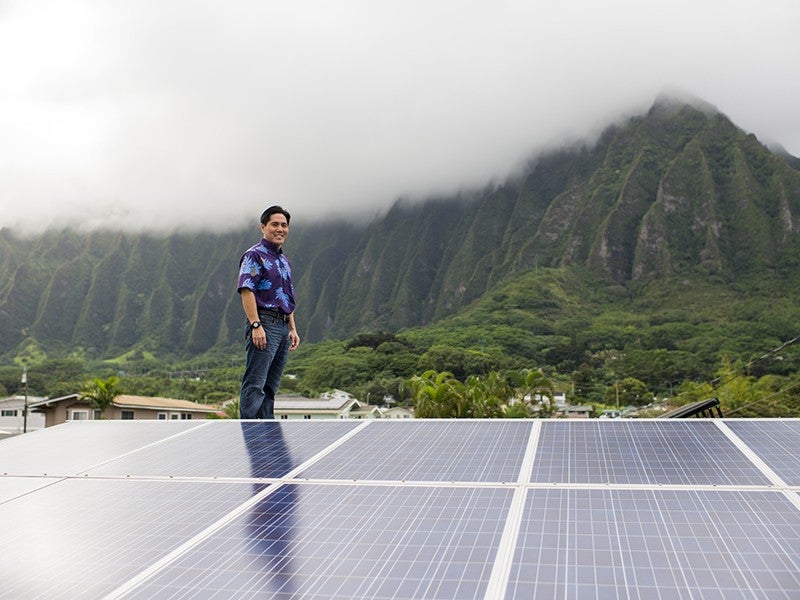10 Years Into Green Energy Law, Move Hawaiʻi Forward
Hawaiʻi led the way in committing to a 100% clean energy future — on the 10th anniversary of that milestone, the state needs to lead more than ever.
Ten years ago, Hawaiʻi made history by enacting the nation’s first 100% renewable energy law. This bold move not only put our state on the path to more affordable and sustainable electricity, it also inspired others to follow. Today, 20 other states and many more cities have joined the 100% club, and most of the U.S. population lives where 100% renewable is the legal mandate.
The faster we can get off fossil fuels, the better for our pocketbooks and planet. Look at Kauaʻi: the island is already at 60% renewable and looking to reach 100% within a decade. Ten years ago, Kauaʻi’s residential rate was 20% more than Oahu’s. Today, it’s 5% less.
The rest of the state can only wish we moved faster this past decade, as fossil fuel prices spike and electric rates hit new highs.
The seas ahead are only getting rougher, as the federal government drags us back to the dark ages by prioritizing fossil fuel industry profits instead of clean energy investments. All the more, then, our state government must rise up to maximize clean energy savings for Hawaiʻi’s people. Standing still means moving us backward.
In the next two years, all hands must be on deck to get projects and programs launched before the federal renewable tax credits expire. Anything less is equivalent to an automatic rate increase on the backs of Hawaiʻi’s energy consumers.
Gov. Josh Green recently protected Hawaiʻi’s residents and economy by vetoing a bill that would’ve axed the state renewable tax credits. He also signed a bill for an innovative “wheeling” program to open up the grid-to-renewable development.
In January, the governor also showed leadership in issuing an executive order to accelerate progress, including an ambitious goal of 50,000 rooftop solar installations by 2030. But little has happened to actually follow through on this direction.
In fact, key agencies have not only been stalling out Hawaiʻi’s progress on clean energy, but are even pulling us backward.
The state Public Utilities Commission, the lead conductor of Hawaiʻi’s electric system, had worked hard over the previous decade to maximize clean energy gains and control utility rates. But the current PUC has reversed direction.
The PUC has stalled or killed programs to give customers, including renters and lower-income households, options to save on their bills through rooftop solar, community solar and smart, time-based rates. Meanwhile, the commission has opened the door for HECO to seek a historic rate hike. These setbacks from all sides keep customers captive with ever-increasing utility bills and nowhere to turn.
A legislative briefing last month publicly displayed how the PUC is “adrift” at this worst possible time. The whistleblower complaint revealed in the briefing further highlights how the collapse in staff capacity and morale at the agency has crippled its ability to protect Hawaiʻi ratepayers.
Hawaiʻi’s State Energy Office has similarly lost its way. Contrary to its legally mandated mission to promote renewable energy, the office has been wasting precious time plugging dead-end plans to bring fossil gas to Hawaiʻi. Liquefied natural gas (LNG) made no sense when we rejected it 10 years ago, and it’s plain insanity now. It’ll lock Hawaiʻi into decades of new fossil fuel infrastructure and, again, stick Hawaiʻi consumers with the bill.
Instead of buying into yesterday’s plans with tomorrow’s money, we should be going all-in on renewables — as the law requires and consumers need. Truly, the last thing Hawaiʻi should be doing is mimicking Donald Trump’s push to put fossil fuel profits over people and the planet.
It all comes down to leadership. Hawaiʻi led the way in committing to a 100% clean energy future and progressing this far. Now, on the 10th anniversary of that milestone, the state needs to lead more than ever.
When we look back at this moment 10 years from now, will we be celebrating more clean energy savings, or regretting the costs of this inaction and distraction?
Established in 1988, Earthjustice's Mid-Pacific Office, located in Honolulu, Hawaiʻi, works on a broad range of environmental and community health issues, including to ensure water is a public trust and to achieve a cleaner energy future.
